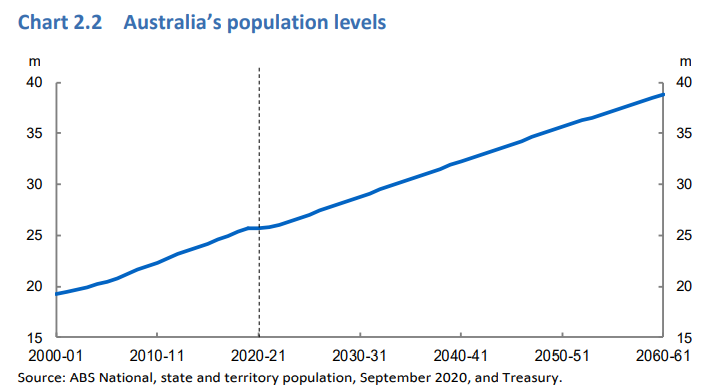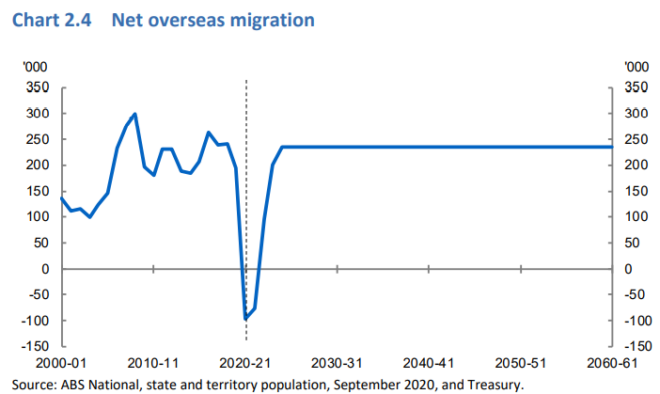With the fierce debate around Australia meeting its “net zero” emissions obligations by 2050, it is worth asking how this target could realistically be achieved with the nation projected in the latest Intergenerational Report (IGR) to add 13.1 million people (a 50% increase) over the next 40 years on the back of extreme immigration levels of 235,000 people a year?


As we know, various vested interests and even the NSW Government has called for an even stronger migration program to make up for the “lost immigration” over the pandemic, which would see Australia’s population grow even more strongly than projected above.
Curiously, there has been minimal push back from climate action groups or environmentalists on the planned reboot of the mass immigration program. This is despite mass immigration making it much harder for Australia to meet its emissions targets, in addition to laying further waste to Australia’s natural environment as land and resources are chewed-up to provide the homes, infrastructure and other goods and services required to meet a much larger population.
The impossibility of Australia meeting its emissions target in the fact of mass immigration was laid bare by lecturers at Deakin University in 2019:
In signing the Paris Climate Agreement, the Australian government committed to a global goal of zero net emissions by 2050. Australia’s promised reductions to 2030, on a per person and emissions intensity basis, exceed even the targets set by the United States, Japan, Canada, South Korea and the European Union.
But are we on the right track to achieve our 2030 target of 26-28% below 2005 levels? With one of the highest population growth rates in the developed world, this represents at least a 50% reduction in emissions per person over the next dozen years.
Consider the impact of one sector, the built environment. The construction, operation and maintenance of buildings accounts for almost a quarter of greenhouse gas emissions in Australia. As Australia’s population grows, to an estimated 31 million in 2030, even more buildings will be needed.
In 2017, around 18,000 dwelling units were approved for construction every month. Melbourne is predicted to need another 720,000 homes by 2031; Sydney, 664,000 new homes within 20 years. Australia will have 10 million residential units by 2020, compared to 6 million in 1990…
A 2018 University of Adelaide-led study entitled Implications of Australia’s Population Policy for Future Greenhouse Gas Emissions Targets also noted the direct (obvious) link between population size, emissions and environmental degradation:
It is clear from our demographic modelling and the available data on net overseas migrants that Australia’s future population is entirely contingent on its immigration policies… The current demographic state of the Australian population is such that if all net immigration were halted today, the population would stabilize by the mid-2040s and decline only slightly thereafter, achieving nearly the same population size that it is today by mid-century…
Whether Australians choose to limit their future population growth is entirely another matter. The country’s natural systems have already suffered severe degradation of ecosystems…
In this context, any policy that seeks an even larger Australian population would need to be carefully focused on how to achieve this goal sustainably, while mitigating (and, in some situations, reversing) these threatening processes. Given the rising environmental damage globally from a large and growing human population (Bradshaw & Brook 2014), Australia has the rare option to limit this damage by adjusting its immigration policies accordingly…
Based on current population policies, the projected growth in the Australian population will make its already challenging future emissions-reduction goals even more difficult to achieve. In addition to the rising pressure of Australia’s population on its ecosystems, the country’s future greenhouse gas emissions are also partially tied to its immigration policy…
With a 2020 target of 5 per cent reduction in emissions (relative to 2000), a 27 per cent reduction by 2030 (relative to 2005) and potentially an 80 per cent reduction by 2050, Australia has no credible mechanisms in place to achieve these goals… it seems unlikely that Australia will be able to achieve either of these two targets without substantial policy changes across population, energy, agriculture and environmental sectors.
Given that Australia has less than 14 years to meet the 2030 target, and less than 34 years to meet the putative 2050 target, and that a reduction in per capita emissions of 83.5 per cent would still be required even under the extreme scenario of no net migration…
Irrespective of these challenges, any increase in Australia’s population will make these targets even more difficult, such that a business-as-usual projection (scenario 1) would require a fivefold greater reduction in per capita emissions to reach a 2050 target of 80 per cent reduction compared with the zero-immigration scenario and produce ~10 per cent more emissions…
More population growth driven by immigration will hamper Australia’s ability to meet its future climate change mitigation commitments and worsen its already stressed ecosystems, unless a massive technological transformation of Australia’s energy sector is immediately forthcoming.
The most recent federal government State of the Environment report also noted the added destruction of Australia’s natural habitat caused by rapid population growth:
Australia’s population growth and economic activity continue to pose major environmental challenges, according to a comprehensive five-yearly stocktake of the country’s environmental health.
The federal government’s State of the Environment 2016 report (prepared by a group of independent experts, which I chaired), released today, predicts that population growth and economic development will be the main drivers of environmental problems such as land-use change, habitat destruction, invasive species, and climate change…
We continue to lose agricultural lands through urban encroachment…
Coastal waterways are threatened by pollutants, including microplastics and nanoparticles…
Population growth in our major cities, along with Australia’s reliance on private cars, is leading to greater traffic volumes, which increase traffic congestion and delays as well as pollution…
While Australia’s emissions depend on many factors – including our energy use patterns, exports, and how we live – nobody can deny the fact that Australia’s high population growth (immigration) policy will make it next to impossible to meet our targets nor safeguard Australia’s environment.
Population multiplied by units of consumption equals total environment impact. It’s not rocket science. Yet population growth is rarely questioned by environmentalists.
Environmentalists state that climate change is a global problem, therefore, it doesn’t matter where people live. Moreover, they claim that slowing Australia’s population growth would do little to stop global over-population.
While climate change is indeed a global problem, most commentators (myself included) believe that Australia should act locally. The only difference is that, unlike me, many of these same commentators do not believe that Australia should act locally on population growth, even though it too is a global problem. Spot the contradiction?
Ultimately, Australia can only control what happens within its own borders. And growing the population so fast via mass immigration is within our direct policy control and unambiguously negative for Australia’s environment, water security, liveability, housing affordability, as well as meeting our emissions reduction targets.
Environmental groups need to stop the hypocrisy and confront Australia’s population addiction head on, since it is a direct driver of our environmental malaise.
Sadly, their cognitive dissonance and concerns of being labelled ‘racist’ or ‘xenophobic’ means that extreme immigration-driven population growth is rarely questioned. This has given the growth lobby free rein to direct policy makers as they see fit.

